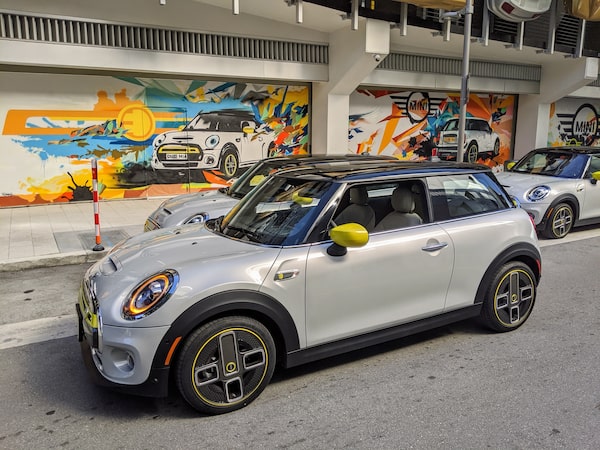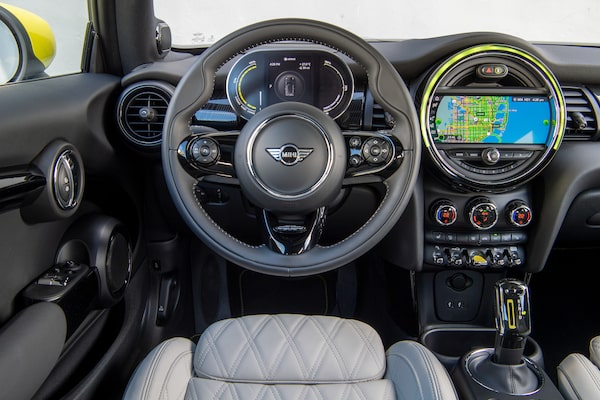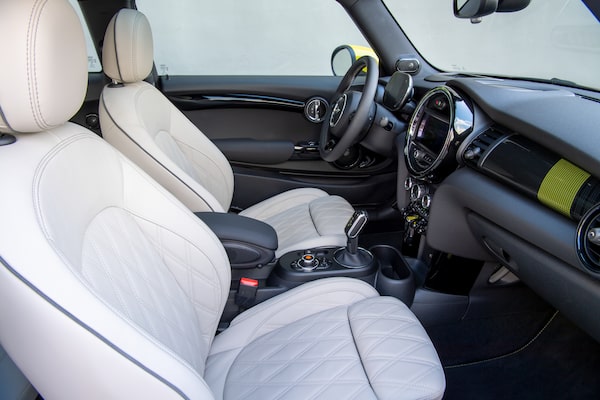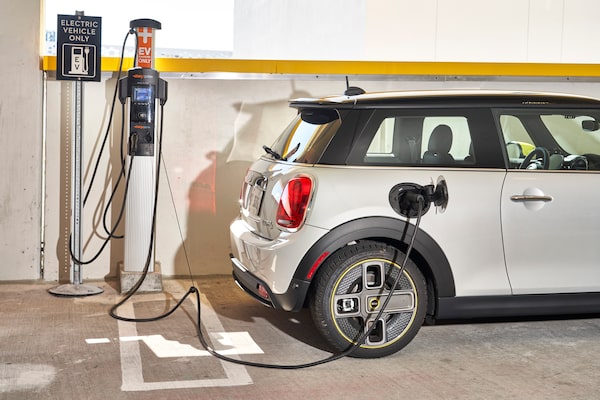
The Mini Cooper SE lunges forward at the slightest prod of the throttle.Matt Bubbers/The Globe and Mail
The ghost of Sir Alec Issigonis haunts this car. Driving the first all-electric Mini, you can’t help but imagine what the inventor of the original would have made of it. As far as automobiles were concerned, Issigonis was a rule-breaker, not a follower.
He was briefly an amateur racing driver, so one imagines he would have, at the very least, enjoyed the way the electric Mini drives; it’s as though a remote-controlled toy has come to life.
The Mini Cooper SE, as it is officially titled, lunges forward at the slightest prod of the throttle. It’s the sort of car that could make a regular person a truly annoying driver; it dares you to dart through every tiny gap in traffic. Each stoplight becomes an opportunity to demonstrate how shockingly quick the electric Mini is. Take a corner at speed and the inside front tire will squeal as it fails to contain the Mini’s power. Press the accelerator to the floor and the prodigious torque of the electric motor tugs the steering wheel from side to side.

A toggle on the dashboard turns on one-pedal driving mode (with aggressive regenerative braking).Courtesy of manufacturer
It’s the sort of grin-inducing performance that can’t be described with numbers. The official 0-100 km/h time of 7.3 seconds is unimpressive. The fun comes from the fact that the electric power kicks in immediately. So, at any legal city speed, there’s instantaneous thrust available. Suffice to say it’s probably more fun to hustle the electric Mini through city traffic than any big-money sports car. Just like the original 1959 Mini, this new one is a joy to drive, but that’s where the similarities end.
Issigonis was born in 1906 in what is, today, the city of Izmir, Turkey. The son of a successful Greek shipbuilder, his family moved to England after the First World War, where Issigonis, like his father and grandfather, became an engineer. While working at the newly formed British Motor Corporation (BMC), in the wake of an oil crisis that saw fuel prices shoot up, he designed an odd-looking but extremely affordable compact car that could fit four adults. (People were smaller in the 1960s.) When the car was launched in 1959, critics mocked the Mini, but it quickly became the best-selling car in Europe. He was quoted in The New York Times, saying the Mini’s beauty lies in its unabashed purposefulness.
The first electric Mini, however, is unlikely to see such blockbuster success.
The simple reason is that Mini Cooper SE has the second shortest driving range of any 2020 electric vehicle in Canada, and range is a key consideration for new EV buyers. The Mini is rated at just 177 kilometres on a single charge, according to Canadian government figures, although in materials shown to the press Mini estimated 235-270 km. Despite having the shortest range in-class, at $39,990 (before government incentives) it’s not significantly cheaper than the competition.

A slick new digital instrument cluster is among the long list of standard equipment, along with navigation, LED lights and heated seats.Courtesy of manufacturer
Mini is following the rules and playing it safe with its first series production electric car.
Development took only two years, according to Christian Schmidt, the head of electrification at Mini. That’s approximately half the time it usually takes to create a new vehicle. The current Mini was never designed to accommodate an electric drivetrain, but the motor from the i3 was made to fit where the gasoline engine once was, and 32.6 kWh battery was shoehorned under and between the seats.
The decision to create an electric Mini now was driven by a combination of factors, Schmidt says. It was partly regulatory pressure, partly maturing EV technology, as well as consumer demand in select regions, such as California and Europe, he explains.
BMW Group, Mini’s parent company, has been timid with EVs since the initial sales flop of the i3, an extremely ambitious electric car that’s still arguably ahead of its time even as it enters its seventh year in production. The company hasn’t launched a new all-electric car in Canada since the i3 – until now.
For most people, the short range of the electric Mini means it will be relegated to second or third car status. In that role, the Mini would be ideal. Then again, so would BMW’s slightly more expensive but longer-range i3. Both are eligible for the $5,000 Federal EV incentive, and more, if you live in B.C. or Quebec.

The motor makes 181 horsepower and 199 lb-ft of torque.www.guenterschmied.com/Courtesy of manufacturer
If an electric car will be your only automobile, you’ll probably want more range, which you can get for less money in the old Volkswagen e-Golf. Or, alternatively, for $5,000 more, the Kia Niro EV and Hyundai Kona EV offer more than double the Mini’s range.
The brand’s image and the car’s funky high-tech interior may be enough to woo some buyers, but this was never intended to be a cheap mass-market product like Issigonis’s original.
He died in 1988, after having seen the one-millionth Mini roll off the assembly line and receiving a knighthood from Queen Elizabeth II.
There is certainly room in the market for an ultra-affordable, bare-bones family-friendly EV – something as revolutionary as Issigonis’ original Mini – but the Cooper SE isn’t it. It doesn’t break any rules, nor any new ground. As wonderful as it is to drive – and it really is – it’s lack of range means it’s likely destined to be a niche product.
With a new chief executive officer in charge of BMW Group, however, the company is putting a renewed focus on EVs. The electric Mini is just the tip of the iceberg, so watch this space.

The battery pack doesn’t take up any passenger or cargo space, so you get exactly the same capacity as in the regular Mini.www.guenterschmied.com/Courtesy of manufacturer
Tech specs
- Base Price: $39,990 (before government EV incentives)
- Engine: Electric motor, 32.6 kWh battery
- Transmissions: N/A
- Driving range (NRCan): 177 km
- Drive: Front-wheel drive
- Alternatives: Hyundai Kona and Ioniq electric, Kia Niro EV and Soul EV, BMW i3, Chevrolet Bolt, Nissan Leaf, Volkswagen e-Golf
Looks
If you like the regular Mini, you’ll like this. It doesn’t shout that it’s electric.
Interior
A slick new digital instrument cluster is among the long list of standard equipment, along with navigation, LED lights and heated seats.
Performance
Compared with the gas-powered Cooper S, the electric version weighs only 145 kilograms more, thanks to relatively small battery. It lowers the centre of gravity, dramatically improving the handling. The motor makes 181 horsepower and 199 lb-ft of torque.
Technology
A toggle on the dashboard turns on one-pedal driving mode (with aggressive regenerative braking). Recharging up to 80 per cent takes just 35 minutes on a DC fast charger, or four hours from a home-installed wall box.
Cargo
The battery pack doesn’t take up any passenger or cargo space, so you get exactly the same capacity as in the regular Mini.
Verdict
It’s fun to drive even in a traffic jam, shame about the range.

The Mini Cooper SE doesn’t shout that it’s electric.www.guenterschmied.com/Courtesy of manufacturer
The writer was a guest of the automaker. Content was not subject to approval.
Shopping for a new car? Check out the new Globe Drive Build and Price Tool to see the latest discounts, rebates and rates on new cars, trucks and SUVs. Click here to get your price.
Stay on top of all our Drive stories. We have a Drive newsletter covering car reviews, innovative new cars and the ups and downs of everyday driving. Sign up today.
 Matt Bubbers
Matt Bubbers